Patient Interview Analysis: Active Listening, Questioning Skills, and Body Language
VerifiedAdded on 2023/06/13
|10
|2280
|225
AI Summary
This analysis discusses the importance of active listening, questioning skills, and body language in patient interviews. It highlights the impact of these skills on the success of the interview process and the development of a therapeutic relationship between the nurse and patient. The analysis also identifies mistakes made during the interview and suggests ways to rectify them. The patient details are fictitious to maintain privacy and confidentiality. The analysis includes references to relevant theories and studies.
Contribute Materials
Your contribution can guide someone’s learning journey. Share your
documents today.
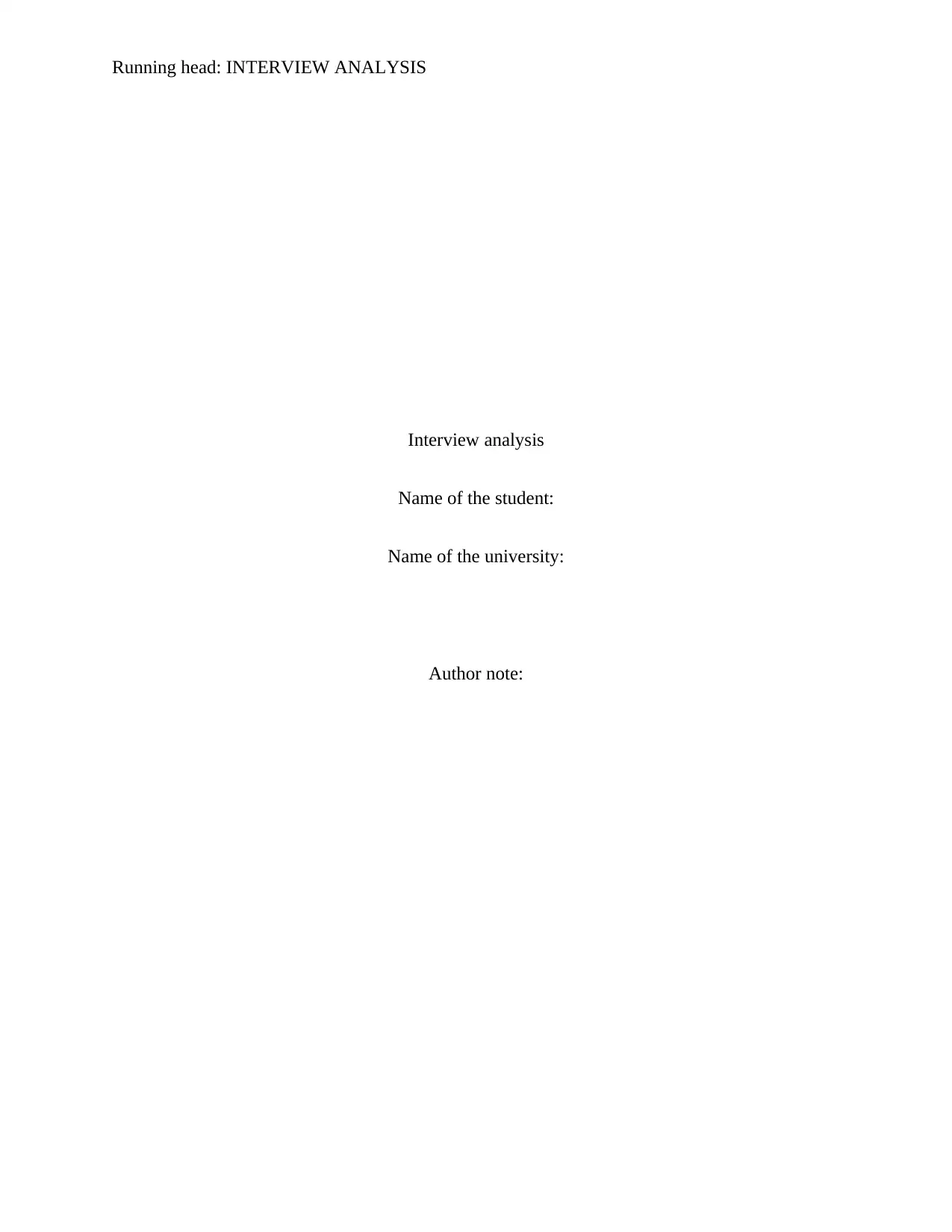
Running head: INTERVIEW ANALYSIS
Interview analysis
Name of the student:
Name of the university:
Author note:
Interview analysis
Name of the student:
Name of the university:
Author note:
Secure Best Marks with AI Grader
Need help grading? Try our AI Grader for instant feedback on your assignments.
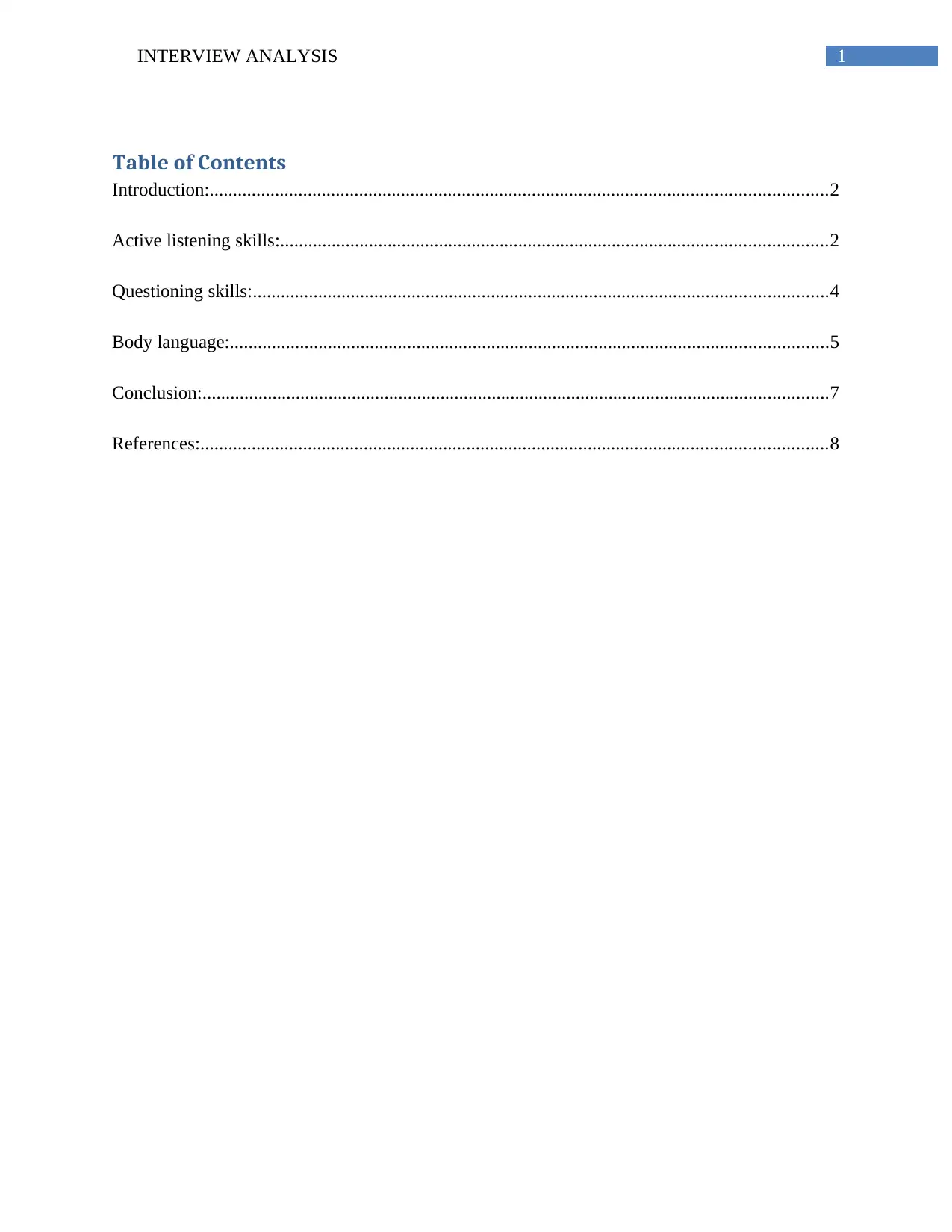
1INTERVIEW ANALYSIS
Table of Contents
Introduction:....................................................................................................................................2
Active listening skills:.....................................................................................................................2
Questioning skills:...........................................................................................................................4
Body language:................................................................................................................................5
Conclusion:......................................................................................................................................7
References:......................................................................................................................................8
Table of Contents
Introduction:....................................................................................................................................2
Active listening skills:.....................................................................................................................2
Questioning skills:...........................................................................................................................4
Body language:................................................................................................................................5
Conclusion:......................................................................................................................................7
References:......................................................................................................................................8
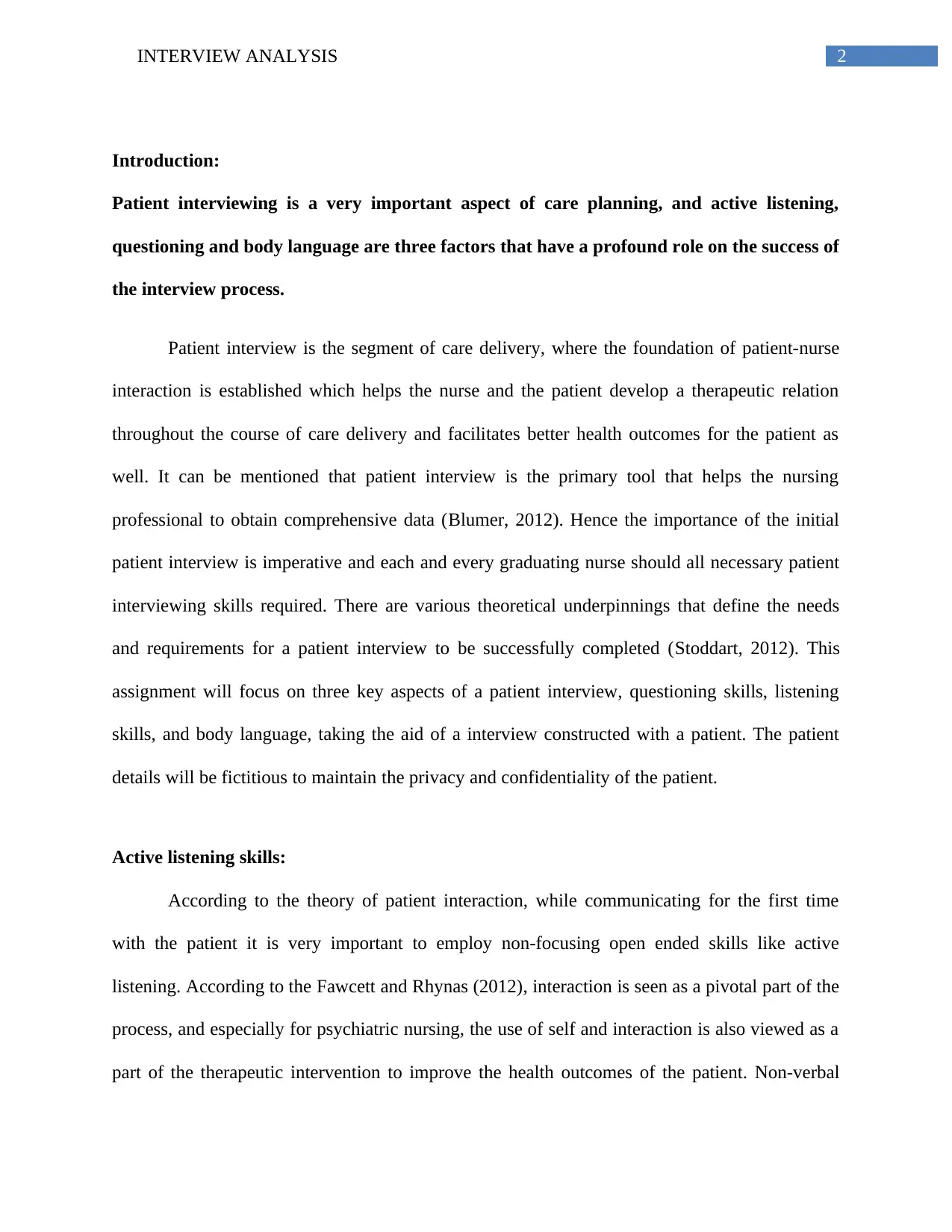
2INTERVIEW ANALYSIS
Introduction:
Patient interviewing is a very important aspect of care planning, and active listening,
questioning and body language are three factors that have a profound role on the success of
the interview process.
Patient interview is the segment of care delivery, where the foundation of patient-nurse
interaction is established which helps the nurse and the patient develop a therapeutic relation
throughout the course of care delivery and facilitates better health outcomes for the patient as
well. It can be mentioned that patient interview is the primary tool that helps the nursing
professional to obtain comprehensive data (Blumer, 2012). Hence the importance of the initial
patient interview is imperative and each and every graduating nurse should all necessary patient
interviewing skills required. There are various theoretical underpinnings that define the needs
and requirements for a patient interview to be successfully completed (Stoddart, 2012). This
assignment will focus on three key aspects of a patient interview, questioning skills, listening
skills, and body language, taking the aid of a interview constructed with a patient. The patient
details will be fictitious to maintain the privacy and confidentiality of the patient.
Active listening skills:
According to the theory of patient interaction, while communicating for the first time
with the patient it is very important to employ non-focusing open ended skills like active
listening. According to the Fawcett and Rhynas (2012), interaction is seen as a pivotal part of the
process, and especially for psychiatric nursing, the use of self and interaction is also viewed as a
part of the therapeutic intervention to improve the health outcomes of the patient. Non-verbal
Introduction:
Patient interviewing is a very important aspect of care planning, and active listening,
questioning and body language are three factors that have a profound role on the success of
the interview process.
Patient interview is the segment of care delivery, where the foundation of patient-nurse
interaction is established which helps the nurse and the patient develop a therapeutic relation
throughout the course of care delivery and facilitates better health outcomes for the patient as
well. It can be mentioned that patient interview is the primary tool that helps the nursing
professional to obtain comprehensive data (Blumer, 2012). Hence the importance of the initial
patient interview is imperative and each and every graduating nurse should all necessary patient
interviewing skills required. There are various theoretical underpinnings that define the needs
and requirements for a patient interview to be successfully completed (Stoddart, 2012). This
assignment will focus on three key aspects of a patient interview, questioning skills, listening
skills, and body language, taking the aid of a interview constructed with a patient. The patient
details will be fictitious to maintain the privacy and confidentiality of the patient.
Active listening skills:
According to the theory of patient interaction, while communicating for the first time
with the patient it is very important to employ non-focusing open ended skills like active
listening. According to the Fawcett and Rhynas (2012), interaction is seen as a pivotal part of the
process, and especially for psychiatric nursing, the use of self and interaction is also viewed as a
part of the therapeutic intervention to improve the health outcomes of the patient. Non-verbal
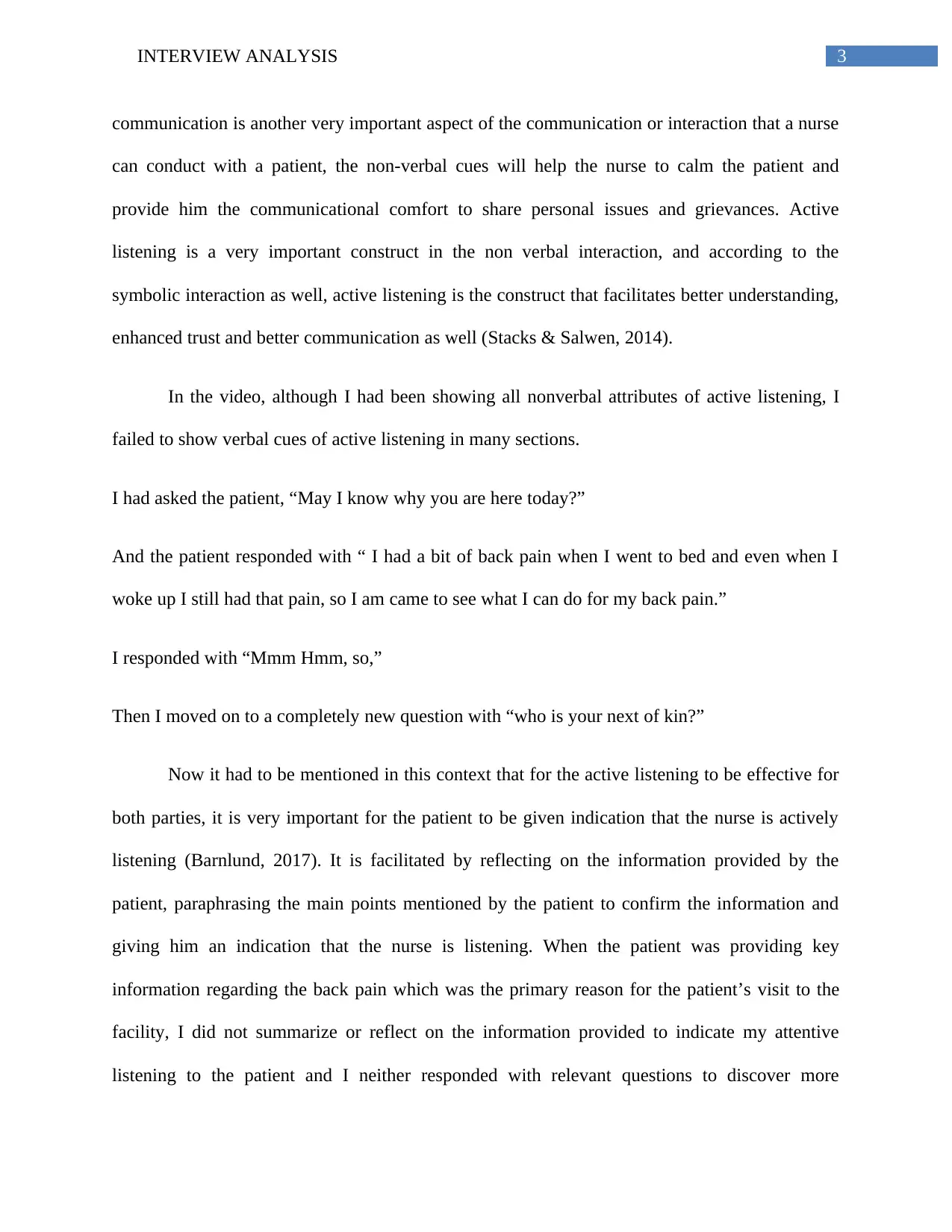
3INTERVIEW ANALYSIS
communication is another very important aspect of the communication or interaction that a nurse
can conduct with a patient, the non-verbal cues will help the nurse to calm the patient and
provide him the communicational comfort to share personal issues and grievances. Active
listening is a very important construct in the non verbal interaction, and according to the
symbolic interaction as well, active listening is the construct that facilitates better understanding,
enhanced trust and better communication as well (Stacks & Salwen, 2014).
In the video, although I had been showing all nonverbal attributes of active listening, I
failed to show verbal cues of active listening in many sections.
I had asked the patient, “May I know why you are here today?”
And the patient responded with “ I had a bit of back pain when I went to bed and even when I
woke up I still had that pain, so I am came to see what I can do for my back pain.”
I responded with “Mmm Hmm, so,”
Then I moved on to a completely new question with “who is your next of kin?”
Now it had to be mentioned in this context that for the active listening to be effective for
both parties, it is very important for the patient to be given indication that the nurse is actively
listening (Barnlund, 2017). It is facilitated by reflecting on the information provided by the
patient, paraphrasing the main points mentioned by the patient to confirm the information and
giving him an indication that the nurse is listening. When the patient was providing key
information regarding the back pain which was the primary reason for the patient’s visit to the
facility, I did not summarize or reflect on the information provided to indicate my attentive
listening to the patient and I neither responded with relevant questions to discover more
communication is another very important aspect of the communication or interaction that a nurse
can conduct with a patient, the non-verbal cues will help the nurse to calm the patient and
provide him the communicational comfort to share personal issues and grievances. Active
listening is a very important construct in the non verbal interaction, and according to the
symbolic interaction as well, active listening is the construct that facilitates better understanding,
enhanced trust and better communication as well (Stacks & Salwen, 2014).
In the video, although I had been showing all nonverbal attributes of active listening, I
failed to show verbal cues of active listening in many sections.
I had asked the patient, “May I know why you are here today?”
And the patient responded with “ I had a bit of back pain when I went to bed and even when I
woke up I still had that pain, so I am came to see what I can do for my back pain.”
I responded with “Mmm Hmm, so,”
Then I moved on to a completely new question with “who is your next of kin?”
Now it had to be mentioned in this context that for the active listening to be effective for
both parties, it is very important for the patient to be given indication that the nurse is actively
listening (Barnlund, 2017). It is facilitated by reflecting on the information provided by the
patient, paraphrasing the main points mentioned by the patient to confirm the information and
giving him an indication that the nurse is listening. When the patient was providing key
information regarding the back pain which was the primary reason for the patient’s visit to the
facility, I did not summarize or reflect on the information provided to indicate my attentive
listening to the patient and I neither responded with relevant questions to discover more
Secure Best Marks with AI Grader
Need help grading? Try our AI Grader for instant feedback on your assignments.
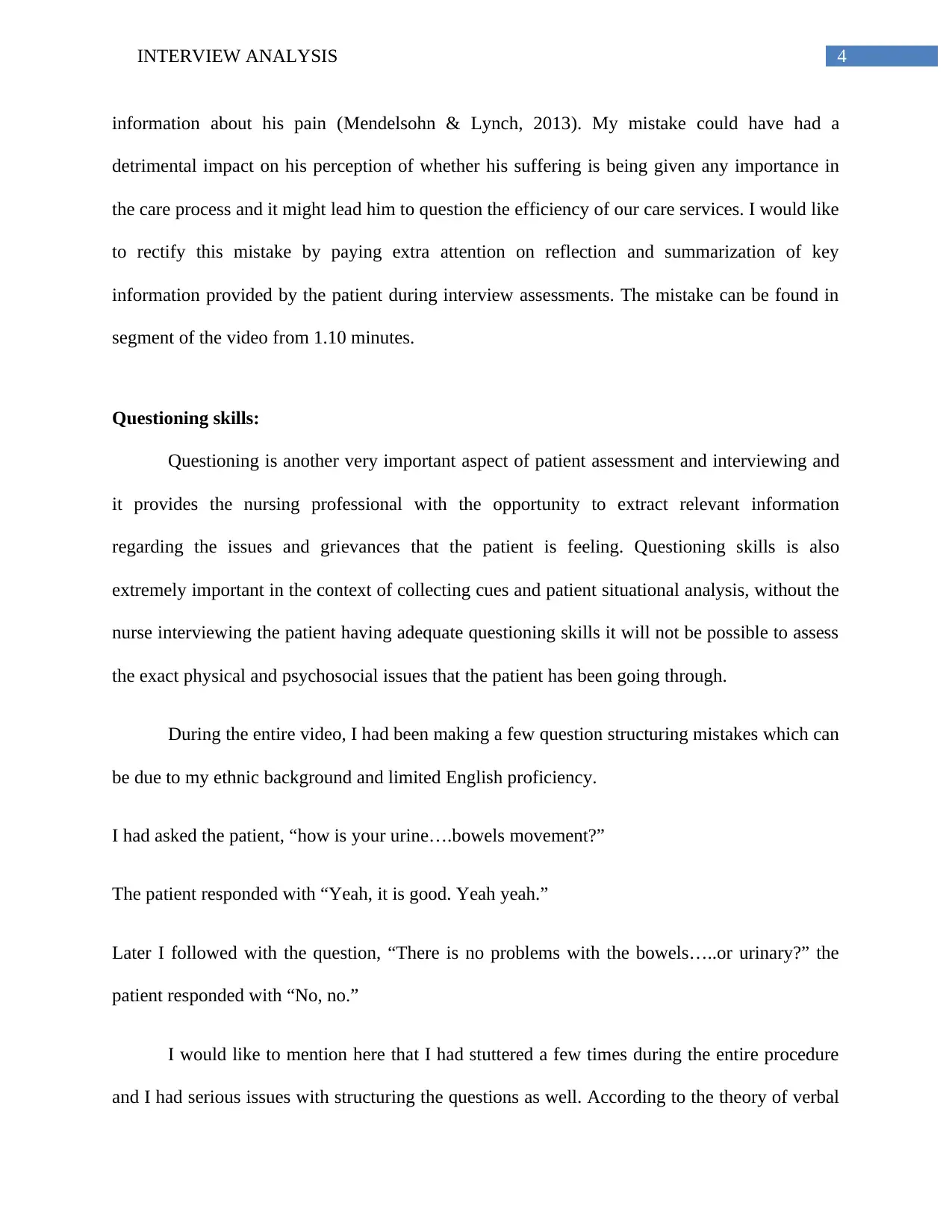
4INTERVIEW ANALYSIS
information about his pain (Mendelsohn & Lynch, 2013). My mistake could have had a
detrimental impact on his perception of whether his suffering is being given any importance in
the care process and it might lead him to question the efficiency of our care services. I would like
to rectify this mistake by paying extra attention on reflection and summarization of key
information provided by the patient during interview assessments. The mistake can be found in
segment of the video from 1.10 minutes.
Questioning skills:
Questioning is another very important aspect of patient assessment and interviewing and
it provides the nursing professional with the opportunity to extract relevant information
regarding the issues and grievances that the patient is feeling. Questioning skills is also
extremely important in the context of collecting cues and patient situational analysis, without the
nurse interviewing the patient having adequate questioning skills it will not be possible to assess
the exact physical and psychosocial issues that the patient has been going through.
During the entire video, I had been making a few question structuring mistakes which can
be due to my ethnic background and limited English proficiency.
I had asked the patient, “how is your urine….bowels movement?”
The patient responded with “Yeah, it is good. Yeah yeah.”
Later I followed with the question, “There is no problems with the bowels…..or urinary?” the
patient responded with “No, no.”
I would like to mention here that I had stuttered a few times during the entire procedure
and I had serious issues with structuring the questions as well. According to the theory of verbal
information about his pain (Mendelsohn & Lynch, 2013). My mistake could have had a
detrimental impact on his perception of whether his suffering is being given any importance in
the care process and it might lead him to question the efficiency of our care services. I would like
to rectify this mistake by paying extra attention on reflection and summarization of key
information provided by the patient during interview assessments. The mistake can be found in
segment of the video from 1.10 minutes.
Questioning skills:
Questioning is another very important aspect of patient assessment and interviewing and
it provides the nursing professional with the opportunity to extract relevant information
regarding the issues and grievances that the patient is feeling. Questioning skills is also
extremely important in the context of collecting cues and patient situational analysis, without the
nurse interviewing the patient having adequate questioning skills it will not be possible to assess
the exact physical and psychosocial issues that the patient has been going through.
During the entire video, I had been making a few question structuring mistakes which can
be due to my ethnic background and limited English proficiency.
I had asked the patient, “how is your urine….bowels movement?”
The patient responded with “Yeah, it is good. Yeah yeah.”
Later I followed with the question, “There is no problems with the bowels…..or urinary?” the
patient responded with “No, no.”
I would like to mention here that I had stuttered a few times during the entire procedure
and I had serious issues with structuring the questions as well. According to the theory of verbal
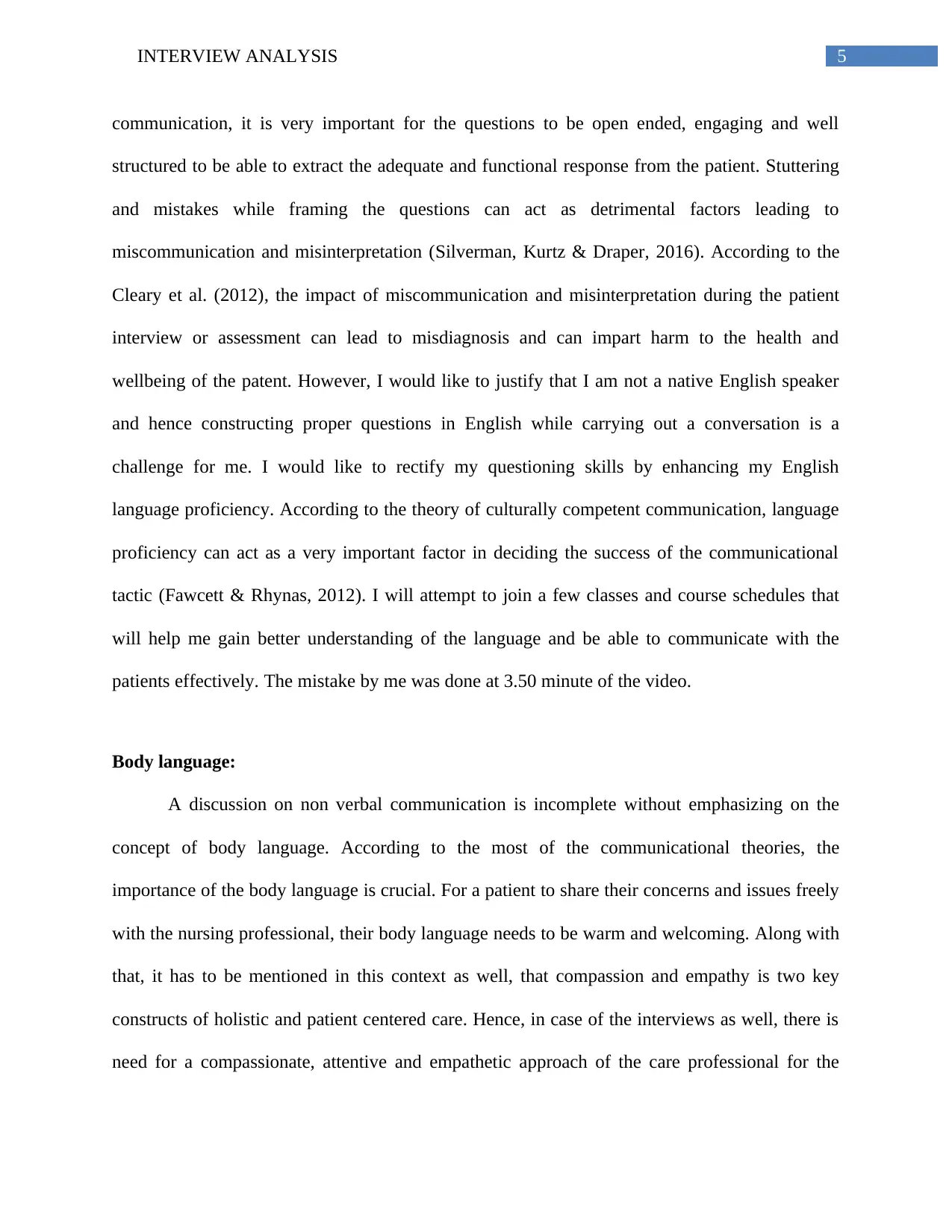
5INTERVIEW ANALYSIS
communication, it is very important for the questions to be open ended, engaging and well
structured to be able to extract the adequate and functional response from the patient. Stuttering
and mistakes while framing the questions can act as detrimental factors leading to
miscommunication and misinterpretation (Silverman, Kurtz & Draper, 2016). According to the
Cleary et al. (2012), the impact of miscommunication and misinterpretation during the patient
interview or assessment can lead to misdiagnosis and can impart harm to the health and
wellbeing of the patent. However, I would like to justify that I am not a native English speaker
and hence constructing proper questions in English while carrying out a conversation is a
challenge for me. I would like to rectify my questioning skills by enhancing my English
language proficiency. According to the theory of culturally competent communication, language
proficiency can act as a very important factor in deciding the success of the communicational
tactic (Fawcett & Rhynas, 2012). I will attempt to join a few classes and course schedules that
will help me gain better understanding of the language and be able to communicate with the
patients effectively. The mistake by me was done at 3.50 minute of the video.
Body language:
A discussion on non verbal communication is incomplete without emphasizing on the
concept of body language. According to the most of the communicational theories, the
importance of the body language is crucial. For a patient to share their concerns and issues freely
with the nursing professional, their body language needs to be warm and welcoming. Along with
that, it has to be mentioned in this context as well, that compassion and empathy is two key
constructs of holistic and patient centered care. Hence, in case of the interviews as well, there is
need for a compassionate, attentive and empathetic approach of the care professional for the
communication, it is very important for the questions to be open ended, engaging and well
structured to be able to extract the adequate and functional response from the patient. Stuttering
and mistakes while framing the questions can act as detrimental factors leading to
miscommunication and misinterpretation (Silverman, Kurtz & Draper, 2016). According to the
Cleary et al. (2012), the impact of miscommunication and misinterpretation during the patient
interview or assessment can lead to misdiagnosis and can impart harm to the health and
wellbeing of the patent. However, I would like to justify that I am not a native English speaker
and hence constructing proper questions in English while carrying out a conversation is a
challenge for me. I would like to rectify my questioning skills by enhancing my English
language proficiency. According to the theory of culturally competent communication, language
proficiency can act as a very important factor in deciding the success of the communicational
tactic (Fawcett & Rhynas, 2012). I will attempt to join a few classes and course schedules that
will help me gain better understanding of the language and be able to communicate with the
patients effectively. The mistake by me was done at 3.50 minute of the video.
Body language:
A discussion on non verbal communication is incomplete without emphasizing on the
concept of body language. According to the most of the communicational theories, the
importance of the body language is crucial. For a patient to share their concerns and issues freely
with the nursing professional, their body language needs to be warm and welcoming. Along with
that, it has to be mentioned in this context as well, that compassion and empathy is two key
constructs of holistic and patient centered care. Hence, in case of the interviews as well, there is
need for a compassionate, attentive and empathetic approach of the care professional for the
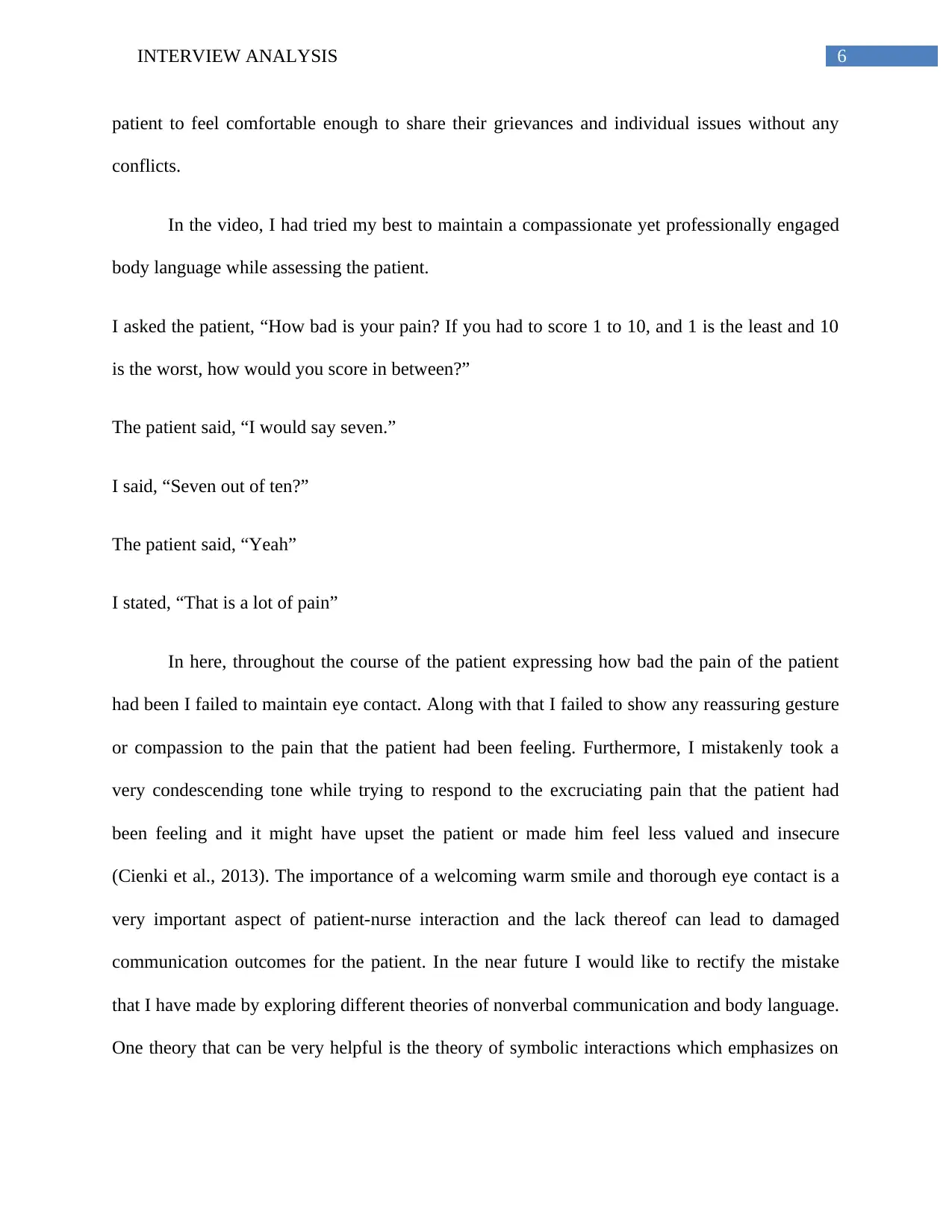
6INTERVIEW ANALYSIS
patient to feel comfortable enough to share their grievances and individual issues without any
conflicts.
In the video, I had tried my best to maintain a compassionate yet professionally engaged
body language while assessing the patient.
I asked the patient, “How bad is your pain? If you had to score 1 to 10, and 1 is the least and 10
is the worst, how would you score in between?”
The patient said, “I would say seven.”
I said, “Seven out of ten?”
The patient said, “Yeah”
I stated, “That is a lot of pain”
In here, throughout the course of the patient expressing how bad the pain of the patient
had been I failed to maintain eye contact. Along with that I failed to show any reassuring gesture
or compassion to the pain that the patient had been feeling. Furthermore, I mistakenly took a
very condescending tone while trying to respond to the excruciating pain that the patient had
been feeling and it might have upset the patient or made him feel less valued and insecure
(Cienki et al., 2013). The importance of a welcoming warm smile and thorough eye contact is a
very important aspect of patient-nurse interaction and the lack thereof can lead to damaged
communication outcomes for the patient. In the near future I would like to rectify the mistake
that I have made by exploring different theories of nonverbal communication and body language.
One theory that can be very helpful is the theory of symbolic interactions which emphasizes on
patient to feel comfortable enough to share their grievances and individual issues without any
conflicts.
In the video, I had tried my best to maintain a compassionate yet professionally engaged
body language while assessing the patient.
I asked the patient, “How bad is your pain? If you had to score 1 to 10, and 1 is the least and 10
is the worst, how would you score in between?”
The patient said, “I would say seven.”
I said, “Seven out of ten?”
The patient said, “Yeah”
I stated, “That is a lot of pain”
In here, throughout the course of the patient expressing how bad the pain of the patient
had been I failed to maintain eye contact. Along with that I failed to show any reassuring gesture
or compassion to the pain that the patient had been feeling. Furthermore, I mistakenly took a
very condescending tone while trying to respond to the excruciating pain that the patient had
been feeling and it might have upset the patient or made him feel less valued and insecure
(Cienki et al., 2013). The importance of a welcoming warm smile and thorough eye contact is a
very important aspect of patient-nurse interaction and the lack thereof can lead to damaged
communication outcomes for the patient. In the near future I would like to rectify the mistake
that I have made by exploring different theories of nonverbal communication and body language.
One theory that can be very helpful is the theory of symbolic interactions which emphasizes on
Paraphrase This Document
Need a fresh take? Get an instant paraphrase of this document with our AI Paraphraser
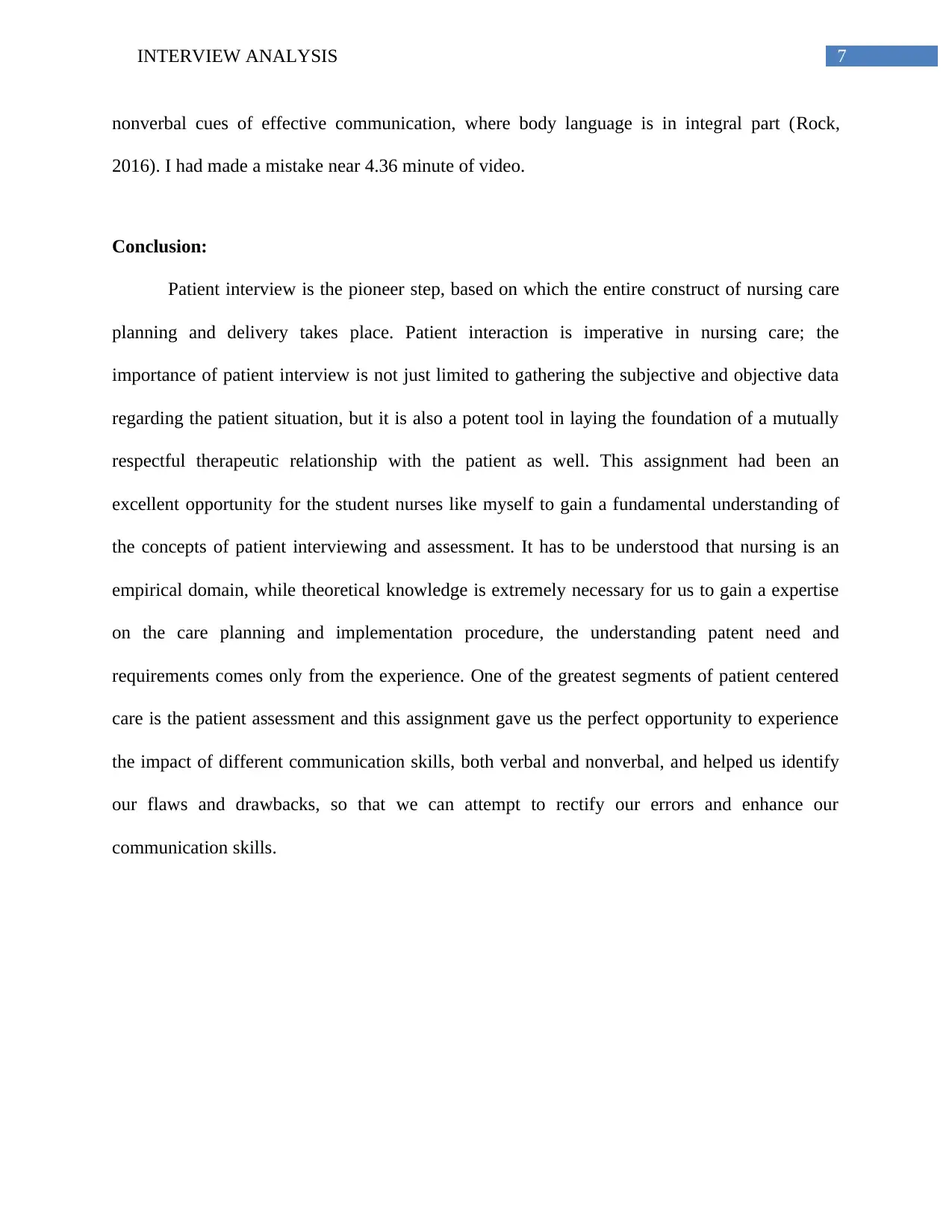
7INTERVIEW ANALYSIS
nonverbal cues of effective communication, where body language is in integral part (Rock,
2016). I had made a mistake near 4.36 minute of video.
Conclusion:
Patient interview is the pioneer step, based on which the entire construct of nursing care
planning and delivery takes place. Patient interaction is imperative in nursing care; the
importance of patient interview is not just limited to gathering the subjective and objective data
regarding the patient situation, but it is also a potent tool in laying the foundation of a mutually
respectful therapeutic relationship with the patient as well. This assignment had been an
excellent opportunity for the student nurses like myself to gain a fundamental understanding of
the concepts of patient interviewing and assessment. It has to be understood that nursing is an
empirical domain, while theoretical knowledge is extremely necessary for us to gain a expertise
on the care planning and implementation procedure, the understanding patent need and
requirements comes only from the experience. One of the greatest segments of patient centered
care is the patient assessment and this assignment gave us the perfect opportunity to experience
the impact of different communication skills, both verbal and nonverbal, and helped us identify
our flaws and drawbacks, so that we can attempt to rectify our errors and enhance our
communication skills.
nonverbal cues of effective communication, where body language is in integral part (Rock,
2016). I had made a mistake near 4.36 minute of video.
Conclusion:
Patient interview is the pioneer step, based on which the entire construct of nursing care
planning and delivery takes place. Patient interaction is imperative in nursing care; the
importance of patient interview is not just limited to gathering the subjective and objective data
regarding the patient situation, but it is also a potent tool in laying the foundation of a mutually
respectful therapeutic relationship with the patient as well. This assignment had been an
excellent opportunity for the student nurses like myself to gain a fundamental understanding of
the concepts of patient interviewing and assessment. It has to be understood that nursing is an
empirical domain, while theoretical knowledge is extremely necessary for us to gain a expertise
on the care planning and implementation procedure, the understanding patent need and
requirements comes only from the experience. One of the greatest segments of patient centered
care is the patient assessment and this assignment gave us the perfect opportunity to experience
the impact of different communication skills, both verbal and nonverbal, and helped us identify
our flaws and drawbacks, so that we can attempt to rectify our errors and enhance our
communication skills.
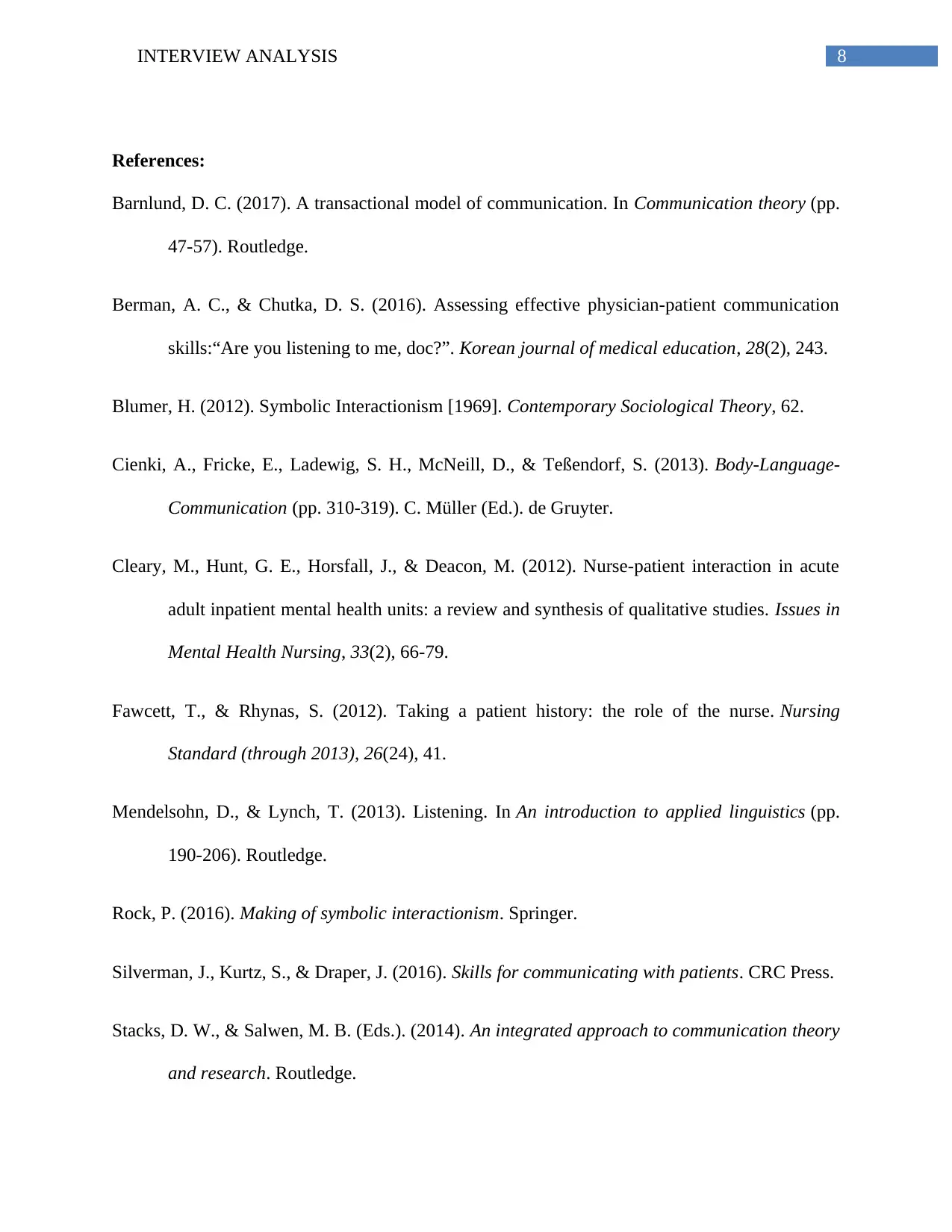
8INTERVIEW ANALYSIS
References:
Barnlund, D. C. (2017). A transactional model of communication. In Communication theory (pp.
47-57). Routledge.
Berman, A. C., & Chutka, D. S. (2016). Assessing effective physician-patient communication
skills:“Are you listening to me, doc?”. Korean journal of medical education, 28(2), 243.
Blumer, H. (2012). Symbolic Interactionism [1969]. Contemporary Sociological Theory, 62.
Cienki, A., Fricke, E., Ladewig, S. H., McNeill, D., & Teßendorf, S. (2013). Body-Language-
Communication (pp. 310-319). C. Müller (Ed.). de Gruyter.
Cleary, M., Hunt, G. E., Horsfall, J., & Deacon, M. (2012). Nurse-patient interaction in acute
adult inpatient mental health units: a review and synthesis of qualitative studies. Issues in
Mental Health Nursing, 33(2), 66-79.
Fawcett, T., & Rhynas, S. (2012). Taking a patient history: the role of the nurse. Nursing
Standard (through 2013), 26(24), 41.
Mendelsohn, D., & Lynch, T. (2013). Listening. In An introduction to applied linguistics (pp.
190-206). Routledge.
Rock, P. (2016). Making of symbolic interactionism. Springer.
Silverman, J., Kurtz, S., & Draper, J. (2016). Skills for communicating with patients. CRC Press.
Stacks, D. W., & Salwen, M. B. (Eds.). (2014). An integrated approach to communication theory
and research. Routledge.
References:
Barnlund, D. C. (2017). A transactional model of communication. In Communication theory (pp.
47-57). Routledge.
Berman, A. C., & Chutka, D. S. (2016). Assessing effective physician-patient communication
skills:“Are you listening to me, doc?”. Korean journal of medical education, 28(2), 243.
Blumer, H. (2012). Symbolic Interactionism [1969]. Contemporary Sociological Theory, 62.
Cienki, A., Fricke, E., Ladewig, S. H., McNeill, D., & Teßendorf, S. (2013). Body-Language-
Communication (pp. 310-319). C. Müller (Ed.). de Gruyter.
Cleary, M., Hunt, G. E., Horsfall, J., & Deacon, M. (2012). Nurse-patient interaction in acute
adult inpatient mental health units: a review and synthesis of qualitative studies. Issues in
Mental Health Nursing, 33(2), 66-79.
Fawcett, T., & Rhynas, S. (2012). Taking a patient history: the role of the nurse. Nursing
Standard (through 2013), 26(24), 41.
Mendelsohn, D., & Lynch, T. (2013). Listening. In An introduction to applied linguistics (pp.
190-206). Routledge.
Rock, P. (2016). Making of symbolic interactionism. Springer.
Silverman, J., Kurtz, S., & Draper, J. (2016). Skills for communicating with patients. CRC Press.
Stacks, D. W., & Salwen, M. B. (Eds.). (2014). An integrated approach to communication theory
and research. Routledge.
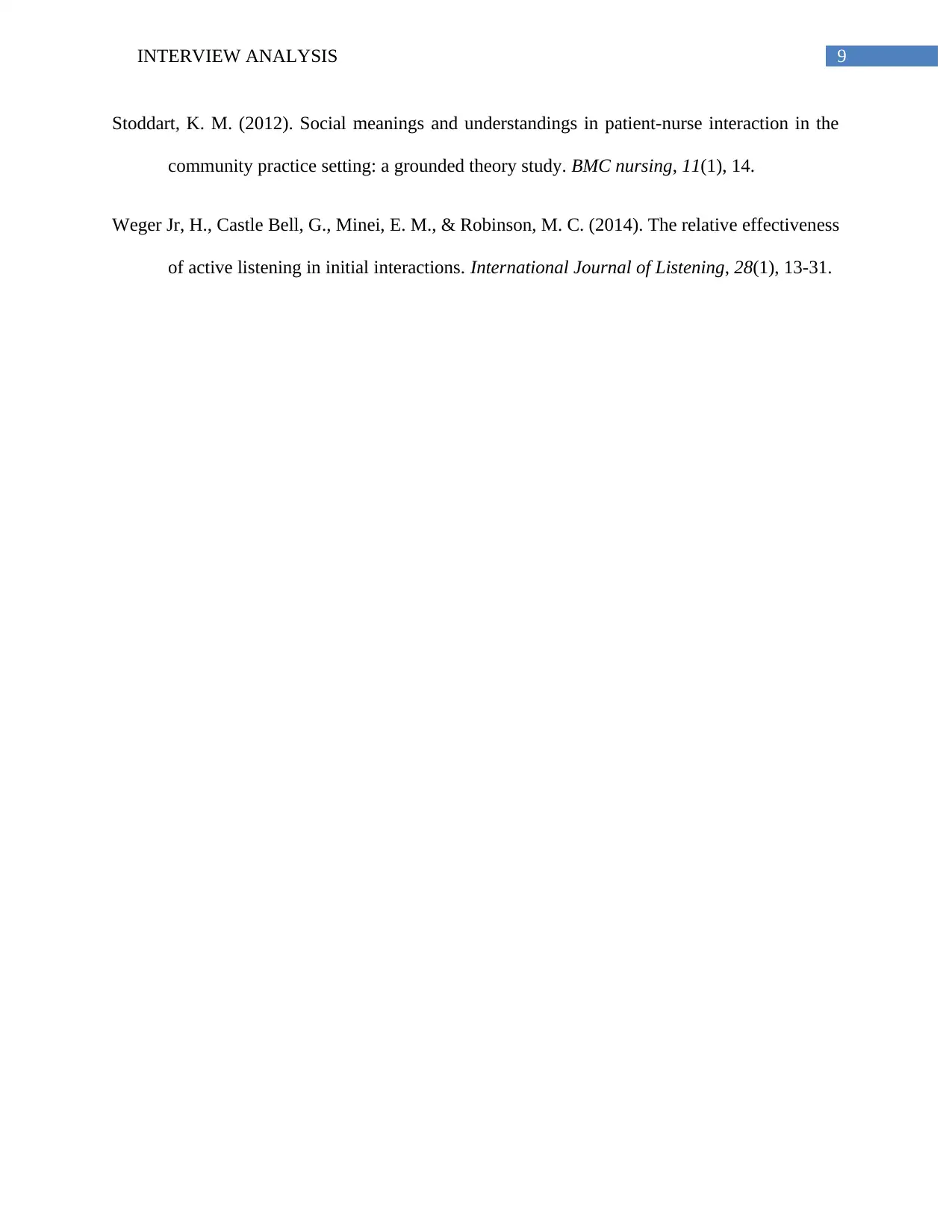
9INTERVIEW ANALYSIS
Stoddart, K. M. (2012). Social meanings and understandings in patient-nurse interaction in the
community practice setting: a grounded theory study. BMC nursing, 11(1), 14.
Weger Jr, H., Castle Bell, G., Minei, E. M., & Robinson, M. C. (2014). The relative effectiveness
of active listening in initial interactions. International Journal of Listening, 28(1), 13-31.
Stoddart, K. M. (2012). Social meanings and understandings in patient-nurse interaction in the
community practice setting: a grounded theory study. BMC nursing, 11(1), 14.
Weger Jr, H., Castle Bell, G., Minei, E. M., & Robinson, M. C. (2014). The relative effectiveness
of active listening in initial interactions. International Journal of Listening, 28(1), 13-31.
1 out of 10
Related Documents
Your All-in-One AI-Powered Toolkit for Academic Success.
+13062052269
info@desklib.com
Available 24*7 on WhatsApp / Email
![[object Object]](/_next/static/media/star-bottom.7253800d.svg)
Unlock your academic potential
© 2024 | Zucol Services PVT LTD | All rights reserved.





